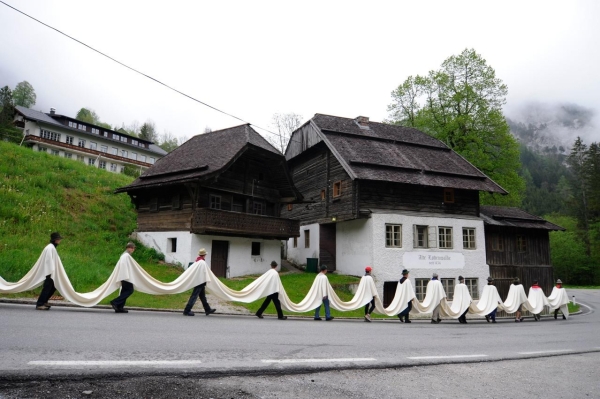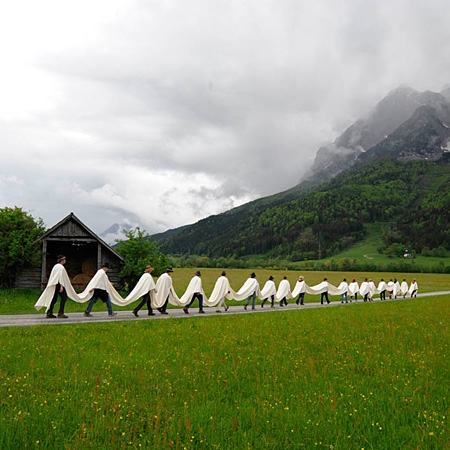Burning Love
3 June – 31 October 2010
Schloss Trautenfels, Styria, Austria
BURNING LOVE (Lodenfüßler), 2010
Performance and Installation with video
© Christian Philipp Müller for regionale 10, 2010
As ever based on astute observations and extensive research, Christian Philipp Müller has realized a new site-specific project entitled ““BURNING LOVE (Lodenfüßler)” (2010) in the surroundings and rooms of Styria’s Schloss Trautenfels castle as part of the exhibition “Fabricators of the World. Scenarios of Self-Will” (curated by Adam Budak).
Müller places loden, a cloth that is produced, processed and worn in this particular area in Austria and both anchors and represents the local identity, at the center of this most recent of his works. “BURNING LOVE (Lodenfüßler)” consists of an exhibition display (in the form of a pictorial tableau mounted to a wall), a performance, and an expansive sculpture. In all of its component this project reviews and activates loden as a cloth has long been worn on the body but, beyond issues of functionality, also forms the metaphorical and metonymical fabric from which the cultural memory, the highly traditional present-day everyday life, and the labor history of a region are made.
As a point of departure, Müller turns an entire panel, more than 150 feet long, of wooly white loden from a local fulling mill into an oversized garment that offers room and protection for no fewer than twenty people. To this end, the artist has cut the required number of circular openings into the loosely woven fabric before it was fulled. In the subsequent outdoor performance, on May 13, Ascension Day, before the exhibition even opened, Müller did send his loden on the roughly 42-kilometres trip from the place of its production to the exhibition rooms at Schloss Trautenfels, thereby referencing to a happening James Lee Byars held at Anny de Decker’s gallery “Wide White Space,” Antwerp, in 1969. Yet Müller’s piece was not creating an opportunity for a happy experience of community; instead, the social cohesion established, then as now, by a piece of fabric is tainted by moments of involuntary membership.
Finally, Müller transformed the communal wooden garment it into a sculpture that, after the prelude made by his tableau on the history and present of the loden, extends through two rooms at the museum, encountering, at the end of the tour, a film that documents the collective effort by which this mass of fabric covered the distance from the fulling mill to the museum. Shapeless in the way of a sculpture that adheres to the aesthetic of post-minimalism, the loden now meets the viewer as a tactile object; where it was once held up and in shape by the heads and bodies of twenty people, simple ”saw horses”, roughly as wide as a pair of shoulders and made, like the interior floors in the castle, of larch wood, now keep it floating above the floor of the exhibition rooms.
“BURNING LOVE (Lodenfüßler)” thus combines a pictorial tableau on the local history of loden with the performative activation of an oversize garment and a sculpture that combines the fabric and its regional connotations with the history of art since minimalism to reflect on the notion and method of site-specificity: The work therein emphasizes that the interrelation between a material and its meaning never comes to rest—on the contrary, as Müller’s deliberately limited perspective on the historical vicissitudes and contradictory current realities of loden demonstrates, its signification is structurally open, eluding the artist’s intention as well as the attempt to tie it irresolvably to one site.
Text by André Rottmann, 2010
[Essay by Adam Budak available here.](http://www.christianphilippmueller.ch/index/texts/budak-adam/burning-love) [Essay by André Rottmann available here.](http://www.christianphilippmueller.ch/index/texts/rottmann-andre/the-fabric-of-art)

